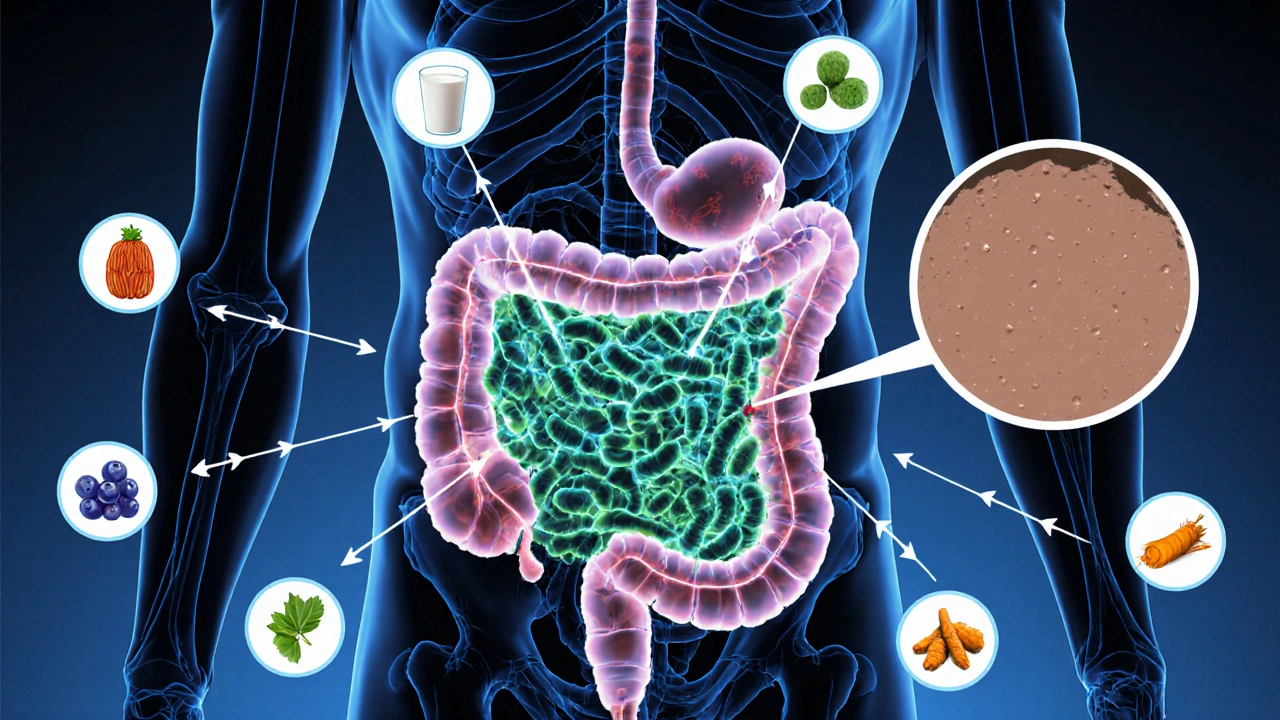Melasma Progress Tracker
Track Your 4-Week Protocol Progress
Monitor your melasma improvement over the 4-week gut-skin protocol. Record your weekly severity score and see if you're seeing the expected 10-15% improvement.
Week 1
Week 2
Week 3
Week 4
How This Works
This tracker helps you see if your gut-skin protocol is working. Based on the article's recommendation:
Your progress will be compared against this benchmark to see if the gut-skin connection is likely helping you.
Results
Progress Summary
Improvement Progress
Personalized Recommendations
Enter your data to see your tailored advice.
Quick Takeaways
- Melasma may be linked to gut‑microbiome imbalances that drive inflammation.
- Probiotic‑rich foods and targeted supplements can support skin clarity for some people.
- Hormonal fluctuations, especially estrogen, are a major driver of melasma, but gut‑derived estrogen metabolism can amplify the effect.
- Adopting a low‑glycemic, antioxidant‑dense diet helps both gut health and pigment regulation.
- Start with a simple 4‑week gut‑skin protocol and monitor any change in melasma patches.
Ever wonder why a sudden flare of dark patches shows up on your cheeks even after you’ve slathered on every lightening cream? You’re not alone. While melasma is traditionally pegged to hormones and sun exposure, a growing body of research hints that the gut might be pulling some strings too.
In this article we’ll unpack what melasma is, how the gut microbiome works, and why the melasma gut health connection matters for anyone fighting stubborn hyperpigmentation. You’ll walk away with clear, actionable steps to test the link for yourself.
What Is Melasma?
Melasma is a chronic skin condition characterized by brown‑gray patches, most often on the cheeks, forehead, upper lip, and bridge of the nose. It tends to affect women of reproductive age, especially those with darker skin tones, and it flares with hormonal shifts - pregnancy, birth control, or menopause - and with UV radiation.
Clinically, melasma is driven by excess melanin production in the epidermis and dermis. The key players are melanocytes, which are stimulated by ultraviolet‑A (UVA) light, estrogen, and inflammatory mediators. Over time, the patches become more resistant to topical lightening agents, leaving many patients frustrated.
Understanding the Gut Microbiome
Enter the Gut microbiome, the trillions‑strong community of bacteria, fungi, and viruses residing primarily in the large intestine. These microbes help digest food, synthesize vitamins, modulate the immune system, and even influence hormone metabolism.
When the microbiome is balanced - a state called eubiosis - it produces short‑chain fatty acids (SCFAs) like butyrate that keep the gut lining tight and reduce systemic inflammation. When it’s out of whack - dysbiosis - the gut becomes leaky, endotoxins spill into circulation, and chronic low‑grade inflammation can affect distant organs, including the skin.
How Gut Health Could Influence Melasma
Three biological pathways link gut health to skin pigmentation:
- Inflammation: Dysbiosis raises levels of pro‑inflammatory cytokines (IL‑6, TNF‑α). Those molecules can trigger melanocytes to produce more melanin.
- Estrogen metabolism: Certain gut bacteria possess β‑glucuronidase enzymes that deconjugate estrogen, allowing more active hormone to re‑enter the bloodstream. Higher free estrogen can intensify melasma.
- Oxidative stress: An unhealthy gut often lacks antioxidant‑producing microbes. The resulting oxidative stress can damage melanocyte DNA, leading to irregular pigment synthesis.
While the exact cause‑and‑effect loop is still under investigation, multiple small‑scale studies (e.g., a 2023 pilot trial in Japan) observed that participants with severe dysbiosis also reported more extensive melasma lesions.
Foods and Supplements That Support Both Gut and Skin
Below is a practical table of gut‑friendly foods, the key nutrients they provide, and the ways they may help melasma.
| Food / Supplement | Primary Gut Benefit | Potential Melasma Impact |
|---|---|---|
| Yogurt (live‑culture) | Provides Probiotics | May lower systemic inflammation, aiding pigment regulation. |
| Kefir | Rich in diverse bacteria and yeasts, improves barrier integrity. | Supports estrogen‑metabolizing microbes, potentially reducing hormonal spikes. |
| Fermented vegetables (kimchi, sauerkraut) | Boosts Prebiotics and probiotic load. | Increases SCFA production, curbing inflammatory triggers. |
| Blueberries | High in anthocyanins, act as antioxidants. | Reduces oxidative stress on melanocytes. |
| Green tea | Contains EGCG, a polyphenol that supports gut barrier. | EGCG has been shown to inhibit tyrosinase, the enzyme that makes melanin. |
| Turmeric (curcumin) | Anti‑inflammatory, modulates gut microbiota composition. | Helps calm cytokine‑driven melanin overproduction. |
| Omega‑3 fish oil | Reduces endotoxin‑induced inflammation. | May support skin barrier recovery and lessen hyperpigmentation. |

Step‑by‑Step 4‑Week Gut‑Skin Protocol
Try this simple plan and keep a weekly photo log. Adjust based on how your skin reacts.
- Week 1 - Clean the Gut: Cut added sugars and refined carbs (they feed harmful bacteria). Add 1 cup of Probiotic yogurt or a daily probiotic capsule (minimum 10 billion CFU).
- Week 2 - Feed the Good Bugs: Include a serving of fermented vegetables daily. Sprinkle chia or flax seeds on smoothies for extra Omega‑3 fatty acids.
- Week 3 - Antioxidant Boost: Drink two cups of green tea and add a handful of berries to each meal. Consider a turmeric supplement (500 mg with black pepper for absorption).
- Week 4 - Hormone‑Balancing Foods: Incorporate cruciferous veggies (broccoli, kale) that support estrogen metabolism. Stay consistent with the probiotic routine.
If you notice at least a 10‑15% lightening of patches after the month, the gut‑skin link is likely playing a role for you.
Potential Pitfalls & How to Avoid Them
Not every gut‑skin experiment works. Here are common missteps:
- Over‑reliance on supplements: Whole foods deliver fiber, polyphenols, and micronutrients together - you can’t replicate that with a single pill.
- Ignoring sun protection: Even with a healthier gut, UV exposure will still drive melanin. Use broad‑spectrum SPF 30+ daily.
- Skipping medical evaluation: Rule out other causes of hyperpigmentation (e.g., medication‑induced, endocrine disorders) with a dermatologist before committing to a gut overhaul.
- Rapid diet changes: Sudden elimination of carbs can cause gut distress. Transition gradually to keep SCFA production steady.
When to Seek Professional Help
If your melasma persists after 8‑12 weeks of gut‑focused lifestyle changes, it’s time to consult a dermatologist. They may recommend:
- Topical agents containing hydroquinone, azelaic acid, or tranexamic acid. \n
- Procedural options such as chemical peels, laser therapy, or microneedling.
- Blood tests to assess estrogen levels, vitamin D status, and inflammatory markers.
Combining medical treatment with a gut‑supportive regimen often yields the best results.
Bottom Line: A Holistic Approach Works Best
Melasma isn’t just a skin problem - it’s a systemic issue that can be nudged in the right direction by feeding your gut the microbes and nutrients it needs. While more large‑scale research is needed, current evidence suggests that reducing inflammation, balancing estrogen metabolism, and protecting against oxidative stress can all tone down excess pigment.
Start with the 4‑week protocol, stay diligent with sunscreen, and keep an eye on how your skin responds. If you see improvement, you’ve likely tapped into the gut‑skin axis - a powerful ally in the fight against melasma.

Can probiotics alone clear melasma?
Probiotics can reduce systemic inflammation and help regulate estrogen, which may soften melasma over time, but they rarely clear it completely on their own. A combined approach with sun protection and, if needed, dermatologic treatment is usually required.
What foods should I avoid if I have melasma?
Limit high‑glycemic foods (white bread, sugary drinks) that spike insulin and can worsen inflammation. Also reduce excessive alcohol and heavily processed snacks that disturb gut balance.
How long does it take to see gut‑related improvements in melasma?
Most people notice subtle lightening after 4‑8 weeks of consistent gut‑supportive eating. Significant changes may require 3‑6 months, especially if underlying hormonal factors are strong.
Is there a link between vitamin D deficiency and melasma?
Low vitamin D is associated with higher inflammation and altered skin barrier function, both of which can aggravate melasma. Ensuring adequate sun‑safe vitamin D (through diet or supplementation) can be a supportive measure.
Should I get a gut microbiome test for melasma?
A stool analysis can reveal dysbiosis and guide probiotic selection, but it isn’t mandatory. Many find success by simply adopting gut‑friendly dietary habits without a formal test.

Emily Collins
Wow, I’ve been battling those stubborn brown patches for years and every new cream feels like another broken promise. The idea that my gut could be the hidden puppeteer behind melasma is both terrifying and hopeful. I’ve cut out sugar, but my skin barely budged, so maybe it’s time to feed the microbes I’ve ignored. The article’s 4‑week protocol looks doable, but I’m nervous about starving my gut with a sudden probiotic surge. If anyone has actually seen a noticeable lightening, spill the beans, because I’m ready to try anything beyond sunscreen.
Harini Prakash
Hey Emily! 🙌 I totally get the frustration – I was in the same boat last year. Adding a cup of live‑culture yogurt each morning and swapping white rice for quinoa made a subtle but real difference for me after about six weeks. It helped calm my gut, and the melasma on my cheeks faded just enough to feel less self‑conscious. Keep a photo diary; you’ll be surprised by the tiny shifts. 🌱
Rachael Turner
I’ve always been skeptical of gut‑skin hype, yet the inflammation pathway does make sense when you think of systemic cytokines roaming the body. The article nails the estrogen‑metabolism angle, which is often overlooked in dermatology circles. I’d suggest pairing the probiotic plan with a gentle, fragrance‑free cleanser to avoid irritating the barrier further. Also, watch out for hidden sugars in “healthy” snack bars – they can sabotage the whole effort. Bottom line, give it a solid month before dismissing the connection.
Vin Alls
Exactly, Rachael! The gut‑skin axis is like a backstage crew that rarely gets applause, but when it’s out of sync the show suffers. Think of the microbiome as a vibrant orchestra; a probiotic dose is the conductor that can bring harmony back. I’d throw in some fermented kimchi and a splash of green tea – those are my go‑to color‑boosting, gut‑loving duo. Trust me, the melasma will start to lose its “spotlight” when the internal crowd cheers.
Tiffany Davis
I’ve tried the low‑glycemic diet and noticed a gentle fade on my forehead. Consistency is key, so keep at it.